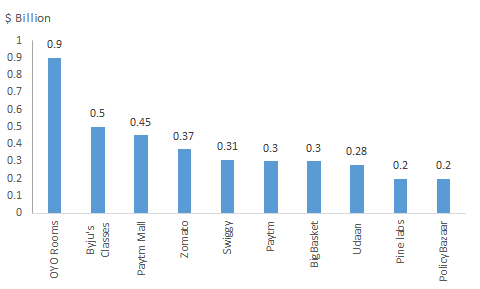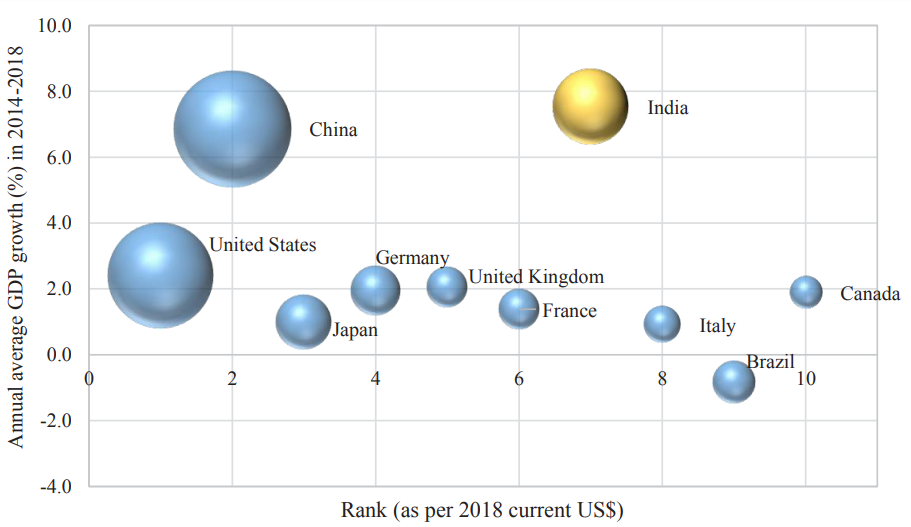Excerpts: Economic Survey 2018-19
Fund-raising by start-ups continued to remain vibrant during fiscal 2019
Trend in Capital raise in last three years

Fund-raising across different sector during fiscal 2019

Fund-raising activities by major start-ups

Jan-Dhan and Aadhar enabling financial inclusion and Direct Benefit Transfers
” The linking of mobile numbers with bank account numbers and subsequently Aadhaar, created a JAM (Jan Dhan, Aadhaar, Mobile) trinity that further secured Direct Benefit Transfers (DBT) to the intended beneficiaries. Presently close to INR 1 lakh crore is deposited in more than 35 crore bank accounts opened under PMJDY . The JAM trinity has enabled cumulative transfers thus far of around INR 7.3 lakh crore”
About Aspirations to be USD 5 trillion Economy by fiscal 2025
“India aims to grow into a USD 5 trillion economy by 2024-25, which will make India the third-largest economy in the world. Given 4% inflation, as the Monetary Policy Framework specified by the Government for the Reserve Bank of India, this requires real annual growth rate in GDP of 8 per cent.”
“Changes in growth of labour force per capita, changes in the savings rate, and changes in the investment rate are three plausible mechanisms by which demographics affects the economic growth .”
“Exports must form an integral part of the growth model because higher savings preclude domestic consumption as the driver of final demand. “
Inadequacy of legal system a hindrance to improve Ease of Doing Business
“Unfortunately, India’s legal system, burdened by 3.5 crore pending cases, is arguably now the single biggest constraint to doing business in India and thereby fostering investment. The World Bank’s latest Ease of Doing Business Report ranked India at 163 for contract enforcement. Experience shows that every other field of economic reform, be it property rights, taxes and insolvency, eventually flounders because it gets entangled in the legal system. This is why the legal sector reforms must be a top priority.”
“India continues to lag on the indicator for enforcing contracts, climbing only one rank from 164 to 163 in the latest report of EODB, 2018. In spite of a number of actions to expedite and improve the contract enforcement regime, economic activity is being affected by the long shadow of delays and pendency across the legal landscape.”
Inability of SMEs with vintage to create jobs in India
The report mentions that the SMEs in India with vintage more than forty years are not creating enough jobs compared to other developing as well developed countries. The report sights that the perks provided by the Government to SMEs leads to many players being content with its “SME” tag. The entrepreneurs rather start a new firm to gain benefits. However, their unwillingness to scale operations impacts their capital raising ability. The Survey therefore provides a case for incentivising new-age Start-ups to grow rather than legacy SMEs
“An average firm in the U.S. employs more than seven times as many workers when it is 40 years of age when compared to the average workers it employed when it was less than five years of age. An average firm in Mexico doubles its employment when it is forty years of age when compared to the workers it employed when it was less than five years of age. In contrast, an average firm in India only employs 40% more workers when it is forty years of age when compared to the workers it employed when it was less than five years of age. Thus, firms in India do not grow enough to create the necessary jobs and productivity in the economy. “
“Job creation in India, however, suffers from policies that foster dwarfs, i.e., small firms that never grow, instead of infant firms that have the potential to grow and become giants rapidly.”
Many Policies/reforms provide incentives for SMEs to remain small
“India has a plethora of labour laws, regulations and rules, both at the centre and the state levels that govern the employer-employee relationship. Each of these legislations exempts smaller firms from complying with these legislations. This restriction is, however, applicable only to firms with more than 100 employees. Thus, firms with less than 100 employees are exempt from the need to get permission from the Government before retrenching their employees. Given the transaction costs inherent in complying with such regulations, naturally a large majority of firms would prefer to be below the threshold of 100 employees.”
“Many policies create a “perverse” incentive for firms to remain small. If the firms grow beyond the thresholds that these policies employ, then they will be unable to obtain the said benefits. Therefore, rather than grow the firm beyond the said threshold, entrepreneurs find it optimal to start a new firm to continue availing these benefits.”
Labour Laws in certain States not conducive to generate employment
“Assam, Jharkhand, Kerala, Bihar, Goa, Chhattisgarh and West Bengal are classified as inflexible states (in terms of labour regulations) while the other 14 states are classified as flexible.”
“Studies have found that on average, plants in labour-intensive industries and in states that have transited towards more flexible labour markets, such as Uttar Pradesh or Gujarat, are 25.4 per cent more productive than their counterparts in states like West Bengal or Chhattisgarh that continue to have labour rigidities.”
Economic Policy Uncertainty has dropped substantially over last few fiscals for India

Investment Rate in India witnessing some Green shoots post Q3 fiscal 2017
Though the investments in the overall economy improved post fiscal 2017, there was slowdown observed in last two quarters (since last quarter of fiscal 2019) which may largely be on account of uncertainty over outcome of Lok Sabha elections.

GDP Growth for fiscal 2020 pegged at 7%
India was the fastest growing major economy during 2014-2018

“Real GDP growth for the year 2019-20 is projected at 7 per cent, reflecting a recovery in the economy after a deceleration in the growth momentum throughout 2018-19. The growth in the economy is expected to pick up in 2019-20 as macroeconomic conditions continue to be stable while structural reforms initiated in the previous few years are continuing on course. However, both downside risks and upside prospects persist in 2019-20.”
“The major threat facing the world economy is the increase in trade tensions between U.S. and China, which could lead to large disruptions in global value chains, outcome of Brexit and downside risk to China’s growth. “
Tax Collections as % of GDP dropped in fiscal 2019 due to shortfall in GST collections

“Though there has been improvement in tax to GDP ratio over the last six years (Figure 3), GTR as a proportion of GDP has declined by 0.3 percentage points in 2018-19 PA over 2017-18. Indirect taxes have fallen by 0.4 percentage points of GDP primarily due to shortfall in GST collections. This has been partly offset by 0.1 percentage points increase in direct taxes.”
Banks increased their lending to NBFC in fiscal 2019
“The banking system faced huge shortage of liquidity for the first time in the fiscal between September 15 and 26 and the deficit was nearly `1.18 lakh crore. The RBI, consequently, announced OMOs of `30,000 crore. This move did ease liquidity temporarily but the liquidity shortage has been persistent .”

HAPPY READING!
*All data points, Quotes in this report are from Economy Survey 2018-19

